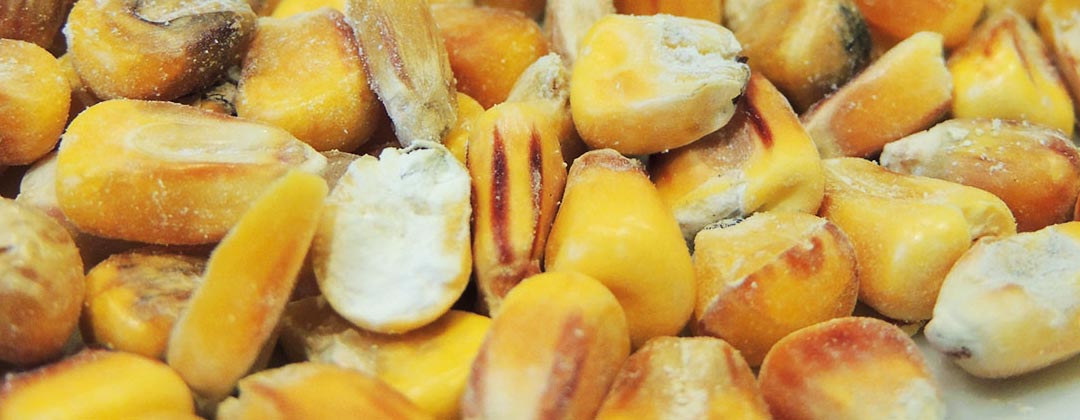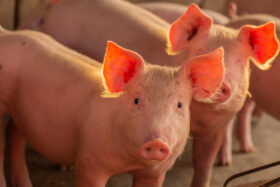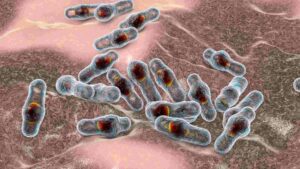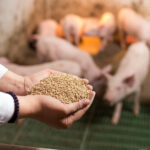by Merideth Parke, Regional Technical Manager, EW Nutrition
To contain and reverse antimicrobial resistance, consumers and government regulators expect changes in pork production with the clear goal to reduce antibiotic use. For healthy, profitable pig production with simultaneous antibiotic reduction, a holistic strategy is required: refocusing human attitudes and habits, optimal pig health and welfare, and applying potential antibiotic alternatives.

Pig producers need to manage pathogenic pressure while reducing antibiotics
Intensive pig production has stress points associated with essential husbandry procedures such as weaning, health interventions, and dietary modifications. Stress is widely accepted to have a negative impact on immune system effectiveness, enhancing opportunities for pathogenic bacteria to invade at a local or systemic level. The gastrointestinal and respiratory systems are highly susceptible to developing disease as a result of these combined factors. Interventions such as antibiotics are commonly implemented to reduce the impact of pathogens and manage pig health. Processes that minimize the number of pathogens in the environment are the foundation for a successful antibiotic reduction plan. The challenge is to smartly combine strategies to keep the gastrointestinal and respiratory tract intact and robust.
Phytomolecules, the specific active defense compounds found in plants, have been identified as capable of enhancing pig health through antimicrobial (Cimanga et al., 2002, Franz et al., 2010), antioxidative (Katalinic et al., 2006, Damjanovic-Vratnica et al., 2007, Lee et al., 2011), digestion-stimulating and immune-supportive functions. As many thousands of phytomolecules exist, laboratory research has focused on identifying those with the capability of microbial management, facilitating the end goal of reducing the reliance on antibiotics for pig health and welfare and the production of safe pork (Zhai et al., 2018).
Which roles can phytomolecules play in reducing antibiotics?
The gastrointestinal tract benefits from applying phytomolecules such as capsaicin, carvacrol, and cinnamaldehyde, as they:
- support a balanced and stable biome,
- prevent dysbiosis, maintain tight junction integrity (Liu et al., 2018),
- increase secretion of digestive enzymes, and
- enhance gut contractility (Zhai et al., 2018).
Pigs most susceptible and in need of phytomolecule gastrointestinal supportive actions are piglets at weaning and pigs of all ages undergoing stress, pathogen challenges, and/or dietary changes.
Porcine respiratory disease is a complex multifactorial disorder. It frequently requires antibiotics to manage infection pressure and clinical disease to maintain pig health, welfare, and production performance. Causal pathogens may be transmitted by direct contact between pigs in saliva (Murase et al., 2018) or bioaerosols (LeBel et al., 2019), via the nasal or oral cavities (inhalation directly into the airways and lungs), or via an unhealthy gut. Phytomolecules such as carvacrol and cinnamaldehyde have antimicrobial properties. Hence, they may help contain respiratory pathogens in their natural habitat (the upper respiratory tract) or during transit through the oronasal cavity and gastrointestinal tract (Swildens et al., 2004, Lee et al., 2001).
In addition to supporting the gastrointestinal and respiratory systems, phytomolecules such as menthol and 1,8-cineole have been shown to enhance the physical and adaptive immune systems in multiple species (Brown et al., 2017, Barbour et al., 2013). When applied via drinking water, adherence to the oronasal mucosa facilitates the inhalation of the active phytomolecule compounds into the respiratory tract. There, they act as mucolytics, muscle relaxants, and enhancers of the mucociliary clearance mechanism (Başer and Buchbauer, 2020). Phytomolecules have also been documented to positively influence the adaptive immune system, promoting both humoral and cell-mediated immune responses (Awaad et al., 2010, Gopi et al., 2014, Serafino et al., 2008).
How phytomolecules feature in the holistic approach to antibiotic reduction
Antibiotic reduction programs positively enact social responsibility by reducing the risk to farmworkers of exposure to antimicrobial-resistant bacteria. They also help maintain or increase efficiency in safe pork production – pork with minimal risk of antibiotic residues.
Implementation of a successful health program with reduced antibiotic use will require:
- application of strict internal and external biosecurity processes;
- evaluation and monitoring of AMR bacteria;
- partnerships with specialist nutritionists to target a lifetime healthy gut biome; and
- phytomolecule-assisted health management (Figure 1).

A combination of in vitro and in vivo studies provides evidence that specific phytomolecules can support both enteric and respiratory systems through biome stabilisation and pathogen management (Bajabai et al., 2020). Antimicrobial activity of thymol, carvacrol, and cinnamaldehyde has been reported against respiratory pathogens including S. suis, A. pleuropneumoniae, and H. parasuis (LeBel et al., 2019); multi-drug resistant and ESBL bacteria (Bozin et al., 2006); enteric pathogens including E. coli, Salmonella enteritidis, Salmonella cholerasuis, and Salmonella typhimurium (Penalver et al., 2005); Clostridium spp., E. coli spp., Brachyspira hyodysenteriae (Vande Maelle et al., 2015); and Lawsonia intracellularis (Draskovic et al., 2018). These results have shown phytomolecules to be effective antimicrobial alternatives for incorporation into holistic pig health programs.
Additionally, the inclusion of phytomolecules into pig production systems also enhances production performance by reducing the negative impact of stress on the pig and increasing the positive effects on gut health and nutrient utilization (Franz et al., 2010). Phytomolecules that directly impact digestive actions include capsaicin, which optimizes the production of digestive enzymes and increases serotonin for gut contraction maintenance and improved digesta mixing (Zhai et al., 2018). Cineol’s antioxidative activities provide support during times of stress (Cimanga et al., 2002).
Phytomolecules are key to reducing antibiotics in pig production
The pig industry searches for alternatives to therapeutic, prophylactic, and growth-promoting antibiotic applications to keep available antibiotics effective for longer – and to address the social responsibility of mitigating AMR. This search for ways to produce safe pork has made it clear that only a combination of management and antibiotic alternatives can achieve these aligned goals.
Biosecurity, hygiene, stress reduction, and husbandry and nutritional advances form the foundation for the strategic application of specific phytomolecules (Zeng et al. 2016). Supporting pig production and health, this complete holistic solution (EIP-AGRI) moves the pig industry into a future where antibiotic reduction or removal, with equivalent or increased production of safe pork, becomes a reality.
References
Awaard M, Abdel-Alim G, Sayed K, Kawkab, Ahmed1 A, Nada A , Metwalli A, Alkhalaf A. “Immunostimulant effects of essential oils of peppermint and eucalyptus in chickens”. Pakistan Veterinary Journal (2010). 2:61-66. http://www.pvj.com.pk/
Bajagai YS, Alsemgeest J, Moore RJ, Van TTH, Stanley D. “Phytogenic products, used as alternatives to antibiotic growth promoters, modify the intestinal microbiota derived from a range of production systems: an in vitro model”. Applied Microbiology and Biotechnology (2020). 104:10631-10640. https://doi.org/10.1007/s00253-020-10998-x
Barbour EK, Shaib H, Azhar E, Kumosani T, Iyer A, Harakey S, Damanhouri G, Chaudary A, Bragg RR. “Modulation by essential oil of vaccine response and production improvement in chicken challenged with velogenic Newcastle disease virus”. Journal of Applied Microbiology (2013). 115, 1278-1286. https://doi:10.1111/jam.12334
Biljana Damjanovic-Vratnica, Tatjana Dakov, Danijela Sukovic, Jovanka Damjanovic. “Antimicrobial effect of essential oil isolated from Eucalyptus globulus Labill” (2011). Czech Journal of Food Science 27(3):277-284. https://www.agriculturejournals.cz/publicFiles/39925.pdf
Bozin B, Mimica-Dukic N, Smin N, Anackov G. “Characterization of the volatile composition of essential oils of some Lamiaceae spices and the antimicrobial and antioxidant activities of the entire oils” Journal of Agriculture and Food Chemicals (2006). 54:1822-1828 https://pubs.acs.org/doi/10.1021/jf051922u
Brown SK, Garver WS, Orlando RA. “1,8-cineole: An Underappreciated Anti-inflammatory Therpeutic” Journal of Biomolecular Research &Therapeutics (2017). 6:1 1-6 https://doi: 10.4172/2167-7956.1000154
Cimanga K., Kambu K., Tona L., Apers S., De Bruyne T., Hermans N., Totte J., Pieters L., Vlietinck A.J. “Correlation between chemical composition and antibacterial activity of essential oils of some aromatic medicinal plants growing in the Democratic Republic of Congo”. Journal of Ethnopharmacology (2002) 79: 213–220. https://doi.org/10.1016/s0378-8741(01)00384-1
Draskovic V, Bosnjak-Neumuller J, Vasiljevic M, Petrujkic B, Aleksic N, Kukolj V, Stanimirovic Z. “Influence of phytogenic feed additive on Lawsonia intracellularis infection in pigs” Preventative Veterinary Medicine (2018). 151: 46-51 https://doi.org/10.1016/j.prevetmed.2018.01.002
European Innovation Partnership Agricultural Productivity and Sustainability (EIP-AGRI). https://ec.europa.eu/eip/agriculture/en/european-innovation-partnership-agricultural
Franz C., Baser KHC, Windisch W. “Essential oils and aromatic plants in animal feeding-a European perspective. A review Flavour”. Flavour and Fragrance Journal (2010) 25:327-40. https://doi.org/10.1002/ffj.1967
Gopi M, Karthik K, Manjunathachar H, Tamilmahan P, Kesavan M, Dashprakash M, Balaraju B, Purushothaman M. “Essential oils as a feed additive in poultry nutrition”. Advances in Animal and Veterinary Sciences (2014) 1:17. https://doi.10.14737/journal.aavs/2014.2.1.1.7
Başer, Kemal Hüsnü Can, and Gerhard Buchbauer. Handbook of Essential Oils Science, Technology, and Applications. Boca Raton: CRC Press, 2020.
Hengziao Zhai, Hong Liu, Shikui Wang, Jinlong Wu, Anna-Maria Kluenter. “Potential of essential oils for poultry and pigs.” Animal Nutrition 4 (2018): 179-186. https://doi.org/10.1016/j.aninu.2018.01.005
Katalinic V., Milos M., Kulisic T., Jukic M. “Screening of 70 medicinal plant extracts for antioxidant capacity and total phenols”. Food Chemistry (2006) 94(4):550-557. https://doi.org/10.1016/j.foodchem.2004.12.004
LeBel G., Vaillancourt K., Bercier P., Grenier D. “Antibacterial activity against porcine respiratory bacterial pathogens and in vitro biocompatibility of essential oils”. Archives of Microbiology (2019) 201:833-840; https://doi.org/10.1007/s00203-019-01655-7
Lee KG, Shibamoto T. “Antioxidant activities of volatile components isolated from Eucalyptus species”. Journal of the Science of Food and Agriculture (2001). 81:1573-1597. https://doi.org/10.1002/jsfa.980
Liu SD, Song MH, Yun W, Lee JH, Lee CH, Kwak WG Han NS, Kim HB, Cho JH. “Effects of oral administration of different dosages of carvacrol essential oils on intestinal barrier function in broilers” Journal of Animal Physiology and Animal Production (2018) https://doi.org/10.1111/jpn.12944
Murase K, Watanabe T, Arai S, Kim H, Tohya M, Ishida-Kuroki K, Vo T, Nguyen T, Nakagawa I, Osawa R, Nguyen N, Sekizaki T. “Characterization of pig saliva as the major natural habitat of Streptococcus suis by analyzing oral, fecal, vaginal, and environmental microbiota”. PLoS ONE (2019). 14(4). https://doi.org/10.1371/journal.pone.0215983
Nethmap MARAN report 2018. https://www.wur.nl/upload_mm/7/b/0/5e568649-c674-420e-a2ca-acc8ca56f016_Maran%202018.pdf
Penalver P, Huerta B, Borge C, Astorga R, Romero R, Perea A. “Antimicrobial activity of 5 essential oils against origin strains of the Enterobacteriaceae family”. Acta Pathologica Microbiologica, et Immunologica Scandinavica (2005) 113:1-6. AromaticScience, LLC Antimicrobial activity of five essential oils against origin strains of the Enterobacteriaceae family.
Serafino A, Vallebona PS, Adnreola F, Zonfrillo M, Mercuri L, Federici M, Rasi G, Garaci E, Pierimarchi P. “Stimulatory effect of Eucalyptus essential oil on innate cell-mediated immune response” BioMed Central (2008). 9:17 https//:doi:10.1186/1471-2172-9-17
Swildens B, Stockhofe-Zurwieden N, van der Meulen J, Wisselink HJ, Nielen M. “Intestinal translocation of Streptococcus suis type 2 EF+ in pigs”. Veterinary Microbiology (2004) 103:29-33. https://doi: 10.1016/j.vetmic.2004.06.010
Vande Maele L, Heyndrickx M, Maes D, De Pauw N, Mahu M, Verlinden M, Haesbrouck F, Martel A, Pasmans F, Boyen F. “In vitro susceptibility of Brachyspira hyodysenteriae to organic acids and essential oil components”. Journal of Veterinary Medical Science (2016). 78(2):325-328. https://doi.org/10/1292/jvms.15-0341
Zeng Z, Zhang S, Wang H, Piao X. “Essential oil and aromatic plants as feed additives in non-ruminant nutrition: a review”. Journal of Animal Science and Biotechnology (2015) 6:7. https://doi.org?10/1186/s40104-015-004-5
















